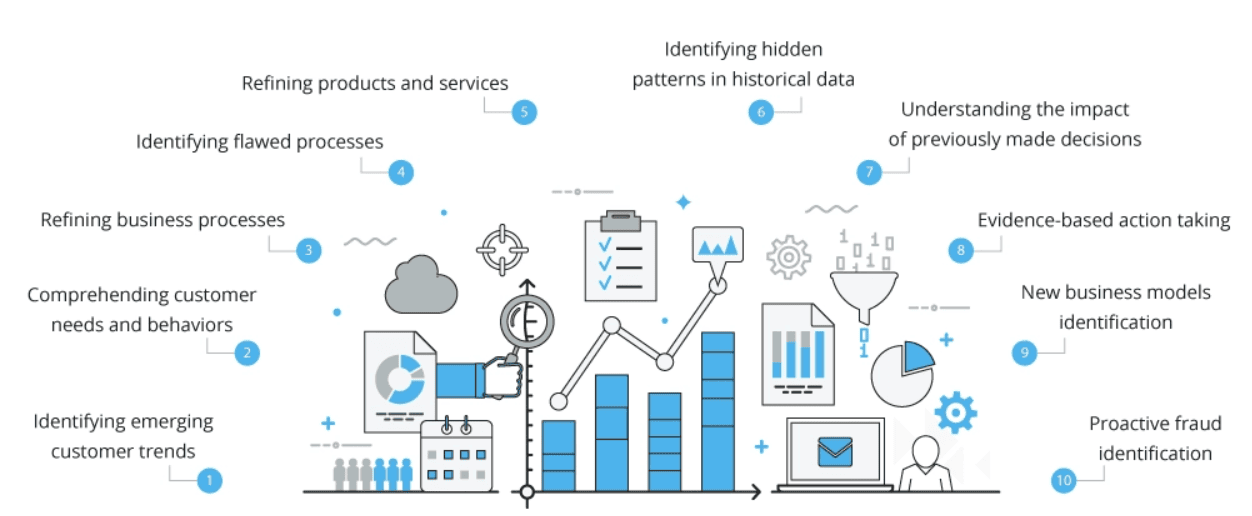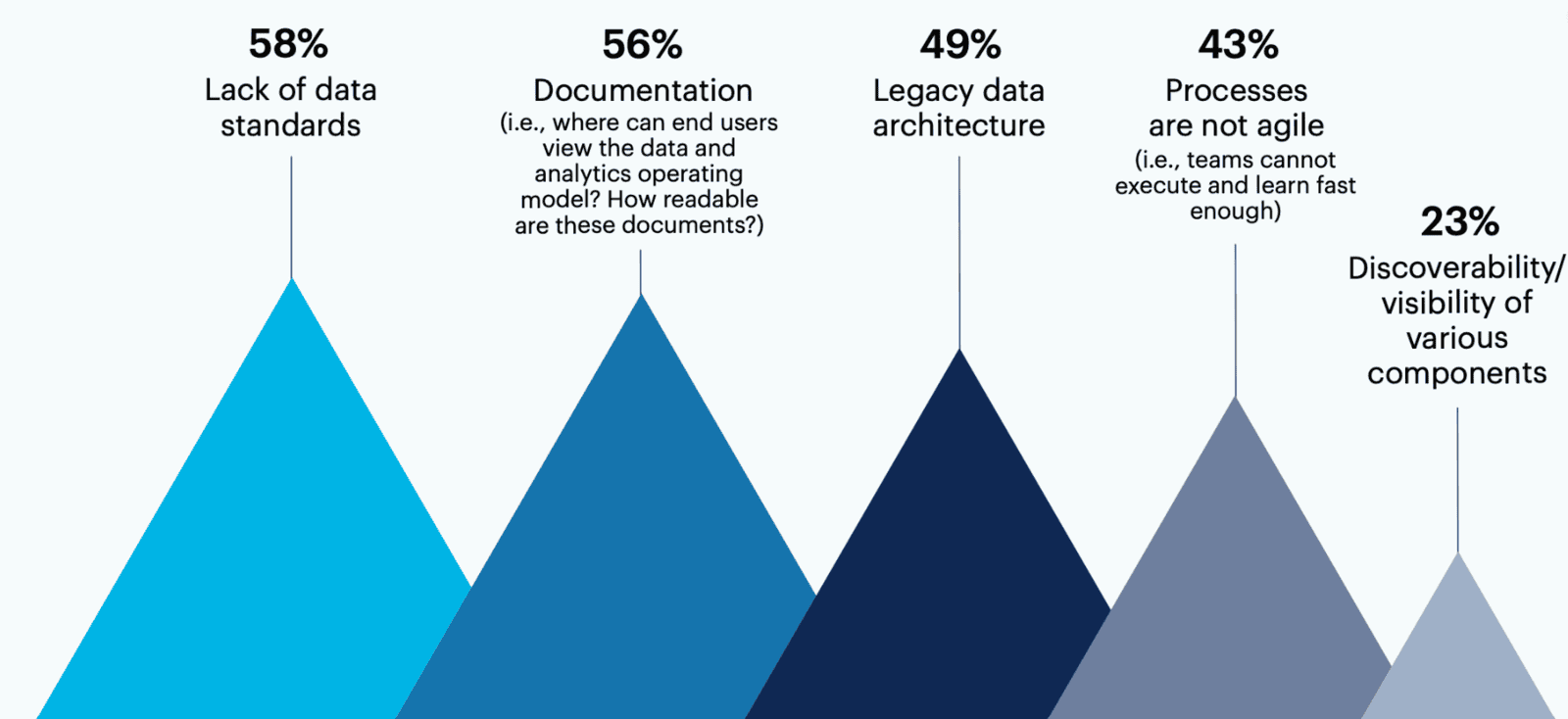The integration of digital solutions into data operating models is increasingly becoming an inevitably critical for businesses of all sizes—small, medium, and large—seeking to leverage data as a core organizational practice. This approach not only enhances decision-making but also positions businesses to be more agile, competitive, and responsive to market demands.

This diagram above expresses different areas within a business that would typically require data usage or interaction with data in some way or form. Below is a comprehensive round-up covering the problems faced by service-oriented businesses at different scales and the digital solutions that can address these challenges.
Challenges in Implementing Data Operating Models
Data Silos:
- Problem: Data silos are a significant challenge, particularly in small and medium-sized enterprises (SMEs) where data is often stored in disparate systems, making it difficult to get a unified view.
- Solution: Implementing a unified data platform or integrating systems via APIs can help eliminate silos, providing a single source of truth. Tools like Zoho Analytics or Microsoft Power BI can facilitate data integration across different platforms.
Limited Resources:
- Problem: SMEs often have limited financial and human resources to invest in complex data management systems.
- Solution: Cloud-based data solutions, such as Google Cloud, AWS, or Azure, offer scalable and cost-effective options that allow SMEs to start small and scale as needed. These platforms provide advanced analytics capabilities without requiring significant upfront investment in infrastructure.
Data Quality and Governance:
- Problem: Ensuring data accuracy and maintaining governance can be challenging, especially as businesses grow and accumulate more data.
- Solution: Implementing data governance frameworks and using data cleansing tools like Talend or Informatica can help maintain data quality. Additionally, adopting standardized processes for data entry and management can reduce errors.
Cultural Resistance:
- Problem: There is often resistance to adopting new data practices, particularly in small businesses where traditional methods are deeply ingrained.
- Solution: Change management strategies, including training and involving employees in the transition process, can help overcome resistance. Encouraging a data-driven culture by demonstrating the tangible benefits of data use in decision-making can also ease the transition.
Scalability:
- Problem: As businesses grow, their data needs become more complex, requiring systems that can scale without losing efficiency or increasing costs disproportionately.
- Solution: Implementing modular data architecture that allows for scalability is crucial. Microservices architecture, where different services can be independently scaled, is an effective approach for businesses of all sizes.
Gartner's report after the Covid pandemic confirms that businesses of all sizes and scale from across industries face similar issues with adaption to comprehensive solutions to enable data usage and practices within their organization. These aspects were categorized by Gartner into 5 buckets, expressed at the diagram above.
Solutions for Small and Medium-Sized Businesses
Cloud-Based Data Platforms:
- Description: Cloud solutions are particularly beneficial for SMEs due to their flexibility, scalability, and cost-effectiveness. Platforms like Zoho Analytics, Google Data Studio, and AWS offer comprehensive tools for data management and analytics without the need for significant capital expenditure.
- Benefit: These platforms provide SMEs with access to the same advanced analytics and data management capabilities that larger enterprises use, but on a scalable and affordable basis.
Data Integration Tools:
- Description: Tools that facilitate data integration, such as Zapier, MuleSoft, or Integromat, allow SMEs to connect various data sources, automating the flow of information between systems.
- Benefit: By integrating disparate data sources, these tools help SMEs eliminate silos and ensure that data is consistently available across the organization, enabling better decision-making.
Data Governance Frameworks:
- Description: Implementing a data governance framework tailored to the needs of SMEs can ensure data quality and compliance. Solutions like Collibra or Alation provide governance tools that are accessible to businesses without extensive data management resources.
- Benefit: A strong governance framework helps maintain data integrity, ensuring that the insights derived from data are reliable and actionable.
Scalable Solutions for Larger Enterprises
Advanced Analytics Platforms:
- Description: Larger businesses can benefit from more advanced analytics platforms like Tableau, Microsoft Power BI, or SAP Analytics Cloud, which offer powerful data visualization, predictive analytics, and AI-driven insights.
- Benefit: These platforms enable large organizations to leverage big data, turning vast amounts of information into actionable insights that drive business strategy and innovation.
Data Lakes and Warehouses:
- Description: Implementing data lakes (such as those offered by AWS or Azure) allows large enterprises to store and analyze massive amounts of structured and unstructured data. This approach supports advanced analytics and machine learning initiatives.
- Benefit: Data lakes provide a flexible, scalable solution for handling large volumes of data, enabling enterprises to extract value from both historical and real-time data.
Automated Data Pipelines:
- Description: Automated data pipelines, using tools like Apache NiFi or Kafka, help large enterprises manage the flow of data from various sources into their data warehouses or lakes.
- Benefit: These pipelines ensure that data is consistently up-to-date and available for analysis, reducing the lag time between data collection and decision-making.
Key Considerations for All Businesses
Security and Compliance:
- Businesses of all sizes must prioritize data security and compliance, especially with regulations like GDPR and CCPA. Implementing robust security measures and ensuring compliance through tools like Data Privacy Manager or OneTrust is essential.
User Training and Adoption:
- Regardless of the size of the business, ensuring that users are trained and comfortable with new data tools is crucial. Providing ongoing training and support can help maximize the value of digital solutions.
Continuous Improvement:
- Data operating models should be continuously evaluated and improved to keep pace with technological advancements and changing business needs. Regular audits and feedback loops can help identify areas for enhancement.
Conclusion
Implementing digital solutions for data operating models is not just a technical challenge; it requires a holistic approach that considers the unique needs of businesses at different scales. By addressing the challenges of data silos, resource limitations, and cultural resistance, and by adopting scalable, cloud-based solutions, businesses can establish data as a core organizational practice. This transformation enables better decision-making, drives efficiency, and ultimately contributes to long-term success in a data-driven world.


